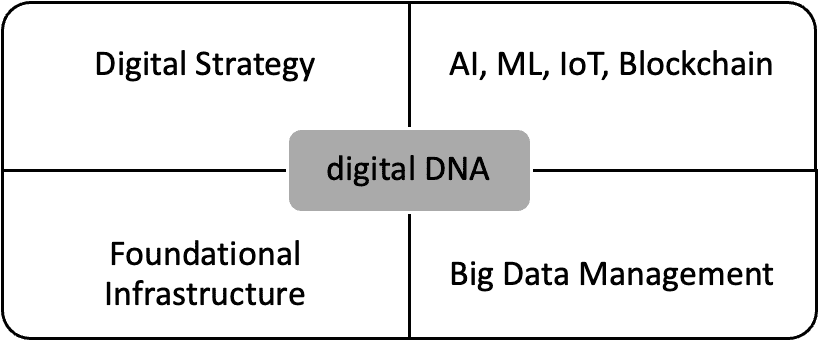
Digital HUB is an open online community of financial and data science professionals pursuing practical applications of AI in their everyday functions. Digital HUB community provides expert, curated insights into financial applications of Generative AI, Large Language Models, Machine Learning, Data Science, Crypto Assets and Blockchain.
A key focus for The Digital HUB publication is to provide best practices for the safe deployment of AI at scale such as: assessing the ability to execute, determining an organization’s digital DNA, fostering skill development, and encouraging responsible AI.
Digital HUB is an open online community of financial and data science professionals pursuing practical applications of AI in their everyday functions. Digital HUB community provides expert, curated insights into financial applications of Generative AI, Large Language Models, Machine Learning, Data Science, Crypto Assets and Blockchain.
A key focus for The Digital HUB publication is to provide best practices for the safe deployment of AI at scale such as: assessing the ability to execute, determining an organization’s digital DNA, fostering skill development, and encouraging responsible AI.
AI Innovations and Impact on Digital Transformation
What is Digital Transformation?
- Implementation of digital technologies to improve customer experience
- Developing digital strategies to enable business operations
- Deploying technologies such as AI, machine learning and automation to improve products and margins
- Transforming the organization to a connected enterprise by breaking the silos of information
- Implementing skills training and development for the digital technologies
- Implementing a culture of continuous product improvement and customer centric organization
The response of enterprises to the digital tsunami due to explosion of alternative data
If you know the answer(s), then you are well underway. If you are not sure, you should find clues as you read through. In any case, I may have a few takeaways for both scenarios; so, read on…
The Digital Tsunami represents different challenges and opportunities for different industries. So, the digital transformation in one industry (or even segments within a given industry) will produce unique offerings depending on your business model. However, there are foundational digital technology elements – such as AI, data science, IoT, big data management – that provide common services for variety of workflow and applications. The leader’s – The CXO’s – response to the digital tsunami, will make or break their organizations as a larger proportion of their services will be in the form of digital solutions. Succeeding in this transformation will position your firm to be the market leader.
To gain prospective on the enormity of challenges and opportunities, we can re-visit the waves of the information revolution with each wave creating big winners and losers. The First wave created the “web presence” market. The second wave produced the “e-Commerce” businesses (Amazon, e-Bay). The third wave, the “Internet of People”, produced Facebook, Google, etc. The fourth wave, the “Internet of Value”, is all about applications of AI, Blockchain, IoT and web3 in industries. The Internet of Value is a much larger wave that will produce new winners with unseen market caps.
For now, the key points are:
What is Digital Transformation?
Digital transformation has been claimed for a wide range of initiatives and offerings including front end customer interfaces in on-line services, chatbots, automation certain workflows to remote operation of industrial facilities. Although, all part of the digital umbrella, a framework with best practices would go a long way in achieving a sustainable digital transformation.
In the following, we will define this framework and its main components. We define the digital Transformation (dTr) as a combination of three main pillars with the following relationship:
The above formula is meant to demonstrate the bigger picture of digital transformation and to introduce methodologies to leverage all the transformative benefits of digitization.
“Ability to Execute” refers to a firm’s proficiency to coordinate abilities and resources across disciplines in an efficient and productive manner.
The “digital DNA” refers to a firm’s capabilities VS what is needed to achieve digital transformation. These capabilities do not just focus on acquiring cutting-edge technology but to complement their technology capabilities with best practices of digital design culture, cross-product Infrastructure, client experience-led workflows.
“Skills development” has been an afterthought in many organizations. To succeed in the fast-moving digital world, a robust skill development program is key.
A framework based on the above components can help your firm assess its current standing and develop a road map to become a market leader through digital transformation.
CXOs have a pivotal role in developing focused organizations to develop and monetize the new solutions. Several industries such as financial services, have already taken significant steps by investing and setting up software platforms offering front-end digital solutions. As a result, they have increased market share with significant new revenue streams. We will discuss some of the best practices in the following sections.
In the following segments, we will examine each of the pillars of the above formula with more detail.
Ability to execute. Involves operational efficiency at scale. Many [digital transformation] pilots fail due to lack of firm’s operational capabilities. Operations at scale, especially in the digital landscape, require breaking down the organizational silos to enable collaboration and information sharing. For example, in legacy organizations, product design has been performed by the “design department” who oversees producing better user interfaces (UI) to make the product “look” better. In the digitally transformed organization, “design” is all about “customer experiences” where multi-disciplinary teams all contribute to the design process.
The digital DNA. Provides a framework for assessing a firm’s “capabilities” in deploying digital offerings. The main components of the digital DNA framework are: The Digital Strategy, digital technologies, foundational infrastructure, and data management as shown in the chart below. Although, new technologies such as AI and machine learning are strong drivers for the digital DNA, other capabilities such as digital strategy, foundational technology infrastructure, and data management need to be in place to achieve digital transformation.
Before adopting any new technology, a solid digital transformation strategy needs to be in place. Digital strategies differ widely depending on the type of business, however, a best practices framework for successful digital journey will help jump start the process.
Another set of challenges for digital transformation are due to the architectural model of technology stack in traditional businesses. The stovepipe model of applications and services has resulted in point-to-point architectures that can’t be scaled across the company value chain. Foundational infrastructure services, using Cloud services, can provide effective integration, agility and scalability for digital technologies such as AI, machine learning. Big data management is a key component of the digital DNA framework. In the last decade, big data has become front and center in data driven businesses and it refers to a set of tools, methods and infrastructure to manage the lifecycle of big data.
With a robust digital DNA in place, transformative technologies such as AI, machine learning, and automation can be deployed at scale.
Skills Development. Refers to retraining vs. replacing the workforce into the next-gen workforce. Firms should consider training and upskilling their current workforce as a critical investment into digital transformation.
With the explosion of AI tools, industrial firms are trying to hire teams that understand AI enough to help direct implementation. Almost every CXO says their biggest roadblock to deploying AI is finding the right engineers and data scientists to help them get there. And even companies in sectors that are further along the AI adoption scale — such as health care, manufacturing and warehousing, finance and banking — find major barriers for scale rollout of AI due to shortage of trained personnel.
For the immediate term, practical on-line courses, and certifications, are in high demand in areas such as AI and data science for executives, data engineering, Natural Language Processing (NLP), digital transformation strategies and scale deployment, and generative AI. This type of training should have embedded low/no code platforms to quickly up-skill employees for developing digital workflows and analytics.
In addition, up-skilling expands the pool of inspired employees with tools to innovate in what is a fast-evolving industry and allows them to play a key part in the next-gen workforce
Use Case – Digitization Opportunities in the Financial Sector
Digital has become the go-to answer for capital markets firms looking to offer new products and gain operational efficiencies. Digital technologies such as AI, machine learning, robotics, natural language processing (NLP), and Distributed Ledger Technology (DLT) have shown a lot of promise for revenue growth and operational efficiencies.
Some of the key digitization opportunities for the capital markets are:
- Front office, automated lead generation for sales traders: banks can use AI-powered chatbots to answer questions, understand what a good lead looks like, and generate leads organically at scale. Technologies such as ChatGPT from Openai, provide significant new capabilities to take the chat function to the next level.
- Automated resolution of margin calls and collateral management disputes: Several banks are testing the use of AI and machine learning to automatically identify, review and categorize margin calls and collateral disputes to comply with regulations such as un-cleared margin rules (UMR). As these tools improve, they can automatically resolve disputes, eliminating the need for manual intervention.
- Regulatory and compliance automation: Advanced analytics tools such as classification models and Natural Language Processing (NLP) have shown to automate contract reviews for regulatory compliance.
- Automation of back-office operations: Blockchain / Digital Ledger Technologies (DLT) have the potential to automate many aspects of the post trade operations. For example, JP Morgan has created a digital currency, JPM Coin, to transact repo market trades with their bank and broker-dealer counterparts. More significantly, equity and commodity settlement can be done with blockchain technologies resulting in solving the ‘age-old’ operational challenge of reducing the T+2 settlement timeline to T+0.
The Takeaways
The digital tsunami is here, and it presents major opportunities and challenges in the digital transformation of Industries. Digital technologies have matured to the point of readiness for large scale deployment by the industries. In this article, we provided a formula for digital transformation of industries consisting of three main pillars:
1) ability to execute,
2) digital DNA capabilities, and
3) skills development program.
We suggested best practice methodologies for assessment and deployment of each pillar. We recommend benchmarking your firm’s score in each pillar against your industry and leverage the following grid to determine your current and future position in your industry.
“Market Leaders” have achieved the best scores of the three pillars of the digital transformation by: 1) continuously improving their digital DNA, 2) building a meticulous operational execution, and 3) creating a culture of learning new skills and sharing at all levels of the organization.
Take time to consider that technology alone will not produce a digitally transformed organization. Following questions will also help in getting started with your digital transformation journey:
1. What is the vision? Articulate your multi-year digital goals. With the vision in place, develop a robust strategic plan.
2. What is your digital DNA score and what are the gaps? This exercise will identify which technologies should be deployed and what are the enabling infrastructure.
3. What is the target operating model? Are you targeting to be the market leader or a follower?
4. Who are the right partners? Identify an ecosystem of partners to accelerate delivery.
…And the correct answer for the questions on the top of the article is: All of The Above!


